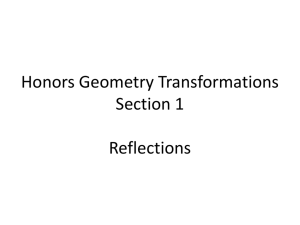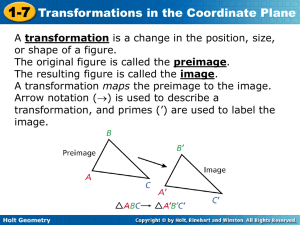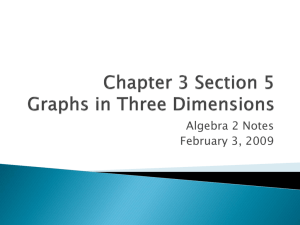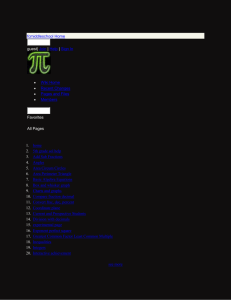File
advertisement
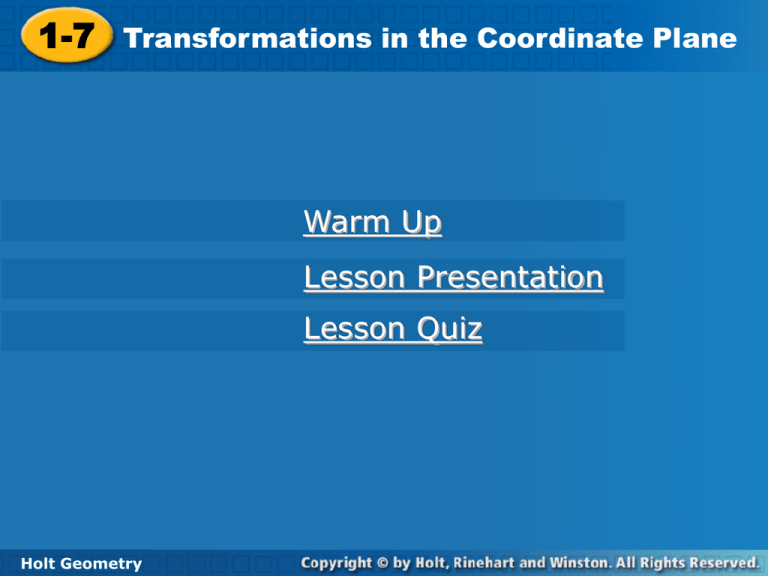
Midpoint and Distance 1-6 1-7 inTransformations in the Coordinate Plane the Coordinate Plane Warm Up Lesson Presentation Lesson Quiz Holt Geometry Holt Geometry 1-6 Midpoint and Distance in the Coordinate Plane Check It Out! Example 5 The center of the pitching mound has coordinates (42.8, 42.8). When a pitcher throws the ball from the center of the mound to home plate, what is the distance of the throw, to the nearest tenth? 60.5 ft Holt Geometry 1-7 Transformations in the Coordinate Plane Objectives Identify reflections, rotations, and translations. Graph transformations in the coordinate plane. Holt Geometry 1-7 Transformations in the Coordinate Plane Vocabulary transformation reflection preimage rotation image symmetry translation (Slide) Holt Geometry 1-7 Transformations in the Coordinate Plane The Alhambra, a 13th-century palace in Grenada, Spain, is famous for the geometric patterns that cover its walls and floors. To create a variety of designs, the builders based the patterns on several different transformations. A transformation is a change in the position, size, or shape of a figure. The original figure is called the preimage. The resulting figure is called the image. A transformation maps the preimage to the image. Arrow notation () is used to describe a transformation, and primes (’) are used to label the image. Holt Geometry 1-7 Transformations in the Coordinate Plane Holt Geometry 1-7 Transformations in the Coordinate Plane Holt Geometry Symmetry Rotation Translation Reflection Symmetry What is a line of symmetry? • A line on which a figure can be folded so that both sides match. To be a line of symmetry, the shape must have two halves that match exactly. When you trace a heart onto a piece of folded paper, and then cut it out, the two half hearts make a whole heart. The two halves are symmetrical. Which of these flags have a line of symmetry? United States of America Maryland Canada England What about these math symbols? Do they have symmetry? How many lines of symmetry to these regular polygons have? Do you see a pattern? You can look to see if your name has symmetrical letters in it too! A B C D E FG HIJKLMN OPQRST UVWXYZ Infinite number Rotation (Turn) The action of turning a figure around a point or a vertex. Click the triangle to see rotation Turning a figure around a point or a vertex Rotation – 90 180 270 45 ? Pre-Image Image 270 Image 90 Image 180 Note: Example Rotation is Clockwise Translation (Slide) The action of sliding a figure in any direction. Click the Octagon to see Translation. The act of sliding a figure in any direction. Reflection (flip) The result of a figure flipped over a line. Graphing Motion Pre-Image Horizontal Translation Vertical Translation Reflection through x-axis Reflection through y-axis 180 Rotation about Origin Dilation (x,y) (x,y) (x,y) (x,y) (x,y) (x,y) Image ( x + h, y ) (x,y+v) ( x , -y ) ( -x , y ) ( -x , -y ) ( nx, ny ) Click on this trapezoid to see reflection. The result of a figure flipped over a line. Which shapes show reflection, translation, or rotation? 1-7 Transformations in the Coordinate Plane Holt Geometry Translations PRESERVE: Size Shape Orientation 1-7 Transformations in the Coordinate Plane Example 2: Drawing and Identifying Transformations A figure has vertices at A(1, –1), B(2, 3), and C(4, –2). After a transformation, the image of the figure has vertices at A'(–1, –1), B'(–2, 3), and C'(–4, –2). Draw the preimage and image. Then identify the transformation. Plot the points. Then use a straightedge to connect the vertices. The transformation is a reflection across the y-axis because each point and its image are the same distance from the y-axis. Holt Geometry 1-7 Transformations in the Coordinate Plane Check It Out! Example 2 A figure has vertices at E(2, 0), F(2, -1), G(5, -1), and H(5, 0). After a transformation, the image of the figure has vertices at E’(0, 2), F’(1, 2), G’(1, 5), and H’(0, 5). Draw the preimage and image. Then identify the transformation. Plot the points. Then use a straightedge to connect the vertices. The transformation is a 90° counterclockwise rotation. Holt Geometry 1-7 Transformations in the Coordinate Plane To find coordinates for the image of a figure in a translation, add a to the x-coordinates of the preimage and add b to the y-coordinates of the preimage. Translations can also be described by a rule such as (x, y) (x + a, y + b). Holt Geometry 1-7 Transformations in the Coordinate Plane Example 3: Translations in the Coordinate Plane Find the coordinates for the image of ∆ABC after the translation (x, y) (x + 2, y - 1). Draw the image. Step 1 Find the coordinates of ∆ABC. The vertices of ∆ABC are A(–4, 2), B(–3, 4), C(–1, 1). Holt Geometry 1-7 Transformations in the Coordinate Plane Example 3 Continued Step 2 Apply the rule to find the vertices of the image. A’(–4 + 2, 2 – 1) = A’(–2, 1) B’(–3 + 2, 4 – 1) = B’(–1, 3) C’(–1 + 2, 1 – 1) = C’(1, 0) Step 3 Plot the points. Then finish drawing the image by using a straightedge to connect the vertices. Holt Geometry 1-7 Transformations in the Coordinate Plane Check It Out! Example 3 Find the coordinates for the image of JKLM after the translation (x, y) (x – 2, y + 4). Draw the image. Step 1 Find the coordinates of JKLM. The vertices of JKLM are J(1, 1), K(3, 1), L(3, –4), M(1, –4), . Holt Geometry 1-7 Transformations in the Coordinate Plane Check It Out! Example 3 Continued Step 2 Apply the rule to find the vertices of the image. J’(1 – 2, 1 + 4) = J’(–1, 5) J’ K’ K’(3 – 2, 1 + 4) = K’(1, 5) L’(3 – 2, –4 + 4) = L’(1, 0) M’(1 – 2, –4 + 4) = M’(–1, 0) Step 3 Plot the points. Then finish drawing the image by using a straightedge to connect the vertices. Holt Geometry M’ L’ 1-7 Transformations in the Coordinate Plane Lesson Quiz: Part I 1. A figure has vertices at X(–1, 1), Y(1, 4), and Z(2, 2). After a transformation, the image of the figure has vertices at X'(–3, 2), Y'(–1, 5), and Z'(0, 3). Draw the preimage and the image. Identify the transformation. translation Holt Geometry 1-7 Transformations in the Coordinate Plane Lesson Quiz: Part II 3. Given points P(-2, -1) and Q(-1, 3), draw PQ and its reflection across the y-axis. 4. Find the coordinates of the image of F(2, 7) after the translation (x, y) (x + 5, y – 6). (7, 1) Holt Geometry
